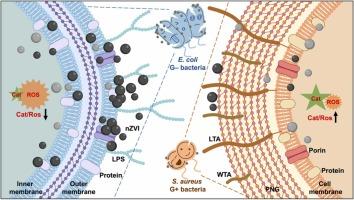革兰氏阴性和革兰氏阳性细菌的不同包膜组成控制着纳米级零价铁的粘附和杀菌性能
IF 11.3
1区 环境科学与生态学
Q1 ENGINEERING, ENVIRONMENTAL
引用次数: 0
摘要
零价铁(Zero-valent-iron, nZVI)是一种候选抗菌剂,以往的研究表明其对革兰氏阴性(G -)和革兰氏阳性(G+)细菌的失活性能不同,但其潜在机制尚不清楚。本文报道了nZVI对大肠杆菌(G -、E. coli)比金黄色葡萄球菌(G+、S. aureus)更容易失活,并揭示了细胞对nZVI吸附的关键作用。与金黄色葡萄球菌相比,nZVI在大肠杆菌表面的粘附量更大,导致大肠杆菌膜损伤更明显。pH、zeta电位和离子强度的研究排除了nzvi -细菌静电相互作用的重要贡献,因为大肠杆菌和金黄色葡萄球菌的表面电荷不同。三维激发发射矩阵表明,大肠杆菌胞外聚合物质受到nZVI的损伤更严重,导致膜暴露更大。红外光谱表明,nZVI与大肠杆菌的膜蛋白结合强烈,破坏了膜成分。相比之下,nZVI与金黄色葡萄球菌之间的结合很小,因为它具有显性的多层肽聚糖。增强的nZVI吸附和膜破坏会导致大肠杆菌活性氧(ROS)的产生和氧化应激的增加。此外,经nZVI处理后,金黄色葡萄球菌的过氧化氢酶活性比大肠杆菌高14.9倍,表明金黄色葡萄球菌具有更强的抗氧化能力。我们的研究结果强调了G -和G+细菌之间不同的包膜组成和抗氧化能力是它们对nZVI的不同敏感性的原因。本文章由计算机程序翻译,如有差异,请以英文原文为准。

Differing envelope composition of Gram-negative and Gram-positive bacteria controls the adhesion and bactericidal performance of nanoscale zero-valent iron
Zero-valent-iron (nZVI) is a candidate antimicrobial agent, and previous works revealed its varying inactivation performance on Gram-negative (G–) and Gram-positive (G+) bacteria, but the underlying mechanism remains ambiguous. Herein, we reported the easier inactivation of Escherichia coli (G–, E. coli) than Staphylococcus aureus (G+, S. aureus) by nZVI, and revealed the key role of cell-nZVI adsorption. nZVI adhered more massively on E. coli surface than on S. aureus, and subsequently led to more pronounced membrane damage of E. coli. Investigations of pH, zeta potential, and ionic strength ruled out the essential contribution of nZVI-bacteria electrostatic interaction due to the different surface charges of E. coli and S. aureus. Three-dimensional excitation emission matrix suggested that the extracellular polymeric substances of E. coli suffered more severe damage by nZVI and lead to greater exposure of membrane. Infrared spectra indicated that nZVI strongly bound with the membrane proteins of E. coli and destroyed the membrane components. By contrast, the bonding between nZVI and S. aureus was minimal because of the dominant multi-layered peptidoglycan. The enhanced nZVI adsorption and membrane disruption would result in magnified reactive oxygen species (ROS) generation and oxidative stress of E. coli. Moreover, the catalase activity normalized by ROS concentration of S. aureus was 14.9-fold higher than that of E. coli after nZVI treatment, suggesting the stronger antioxidative capability of S. aureus. Our findings highlight that the different envelope compositions and antioxidant capacities between G– and G+ bacteria were responsible for their varying susceptibility to nZVI.
求助全文
通过发布文献求助,成功后即可免费获取论文全文。
去求助
来源期刊

Journal of Hazardous Materials
工程技术-工程:环境
CiteScore
25.40
自引率
5.90%
发文量
3059
审稿时长
58 days
期刊介绍:
The Journal of Hazardous Materials serves as a global platform for promoting cutting-edge research in the field of Environmental Science and Engineering. Our publication features a wide range of articles, including full-length research papers, review articles, and perspectives, with the aim of enhancing our understanding of the dangers and risks associated with various materials concerning public health and the environment. It is important to note that the term "environmental contaminants" refers specifically to substances that pose hazardous effects through contamination, while excluding those that do not have such impacts on the environment or human health. Moreover, we emphasize the distinction between wastes and hazardous materials in order to provide further clarity on the scope of the journal. We have a keen interest in exploring specific compounds and microbial agents that have adverse effects on the environment.
 求助内容:
求助内容: 应助结果提醒方式:
应助结果提醒方式:


